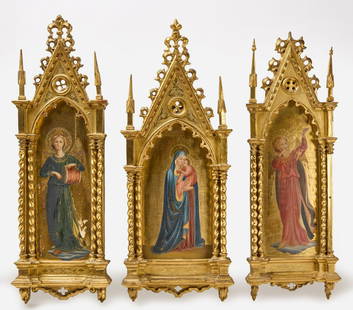
ROME COLOSSEUM GRAND TOUR MICROMOSAIC PLAQUE Circ 1870
Similar Sale History
View More Items in IconsRelated Icons
More Items in Icons
View MoreRecommended Religious & Spiritual Objects
View More










Item Details
Description
ROME COLOSSEUM GRAND TOUR MICROMOSAIC PLAQUE Circ 1870
A rare and important micromosaic rectangular plaque, Italy, third quarter of the 19th century, colorfully depicting a Grand Tour scene featuring Europeans strolling about the ruins of the Colosseum in Rome, housed in a period gilt floral form frame, is of museum quality and would make an impressive addition to any fine household or collection.
DETAILS:
SIZE: 15-1/4 x 10-1/8 In. (artwork) x 20-3/4 x 15-3/4 In. (framed).
CONDITION: Excellent.
BACKGROUND: Grand Tour
The Grand Tour was the traditional travel of Europe undertaken by mainly upper-class European young men of means. The custom flourished from about 1660 until the advent of large-scale rail transit in the 1840s, and was associated with a standard itinerary. It served as an educational rite of passage.
BACKGROUND: Micromosaics
Micromosaics (or micro mosaics, micro-mosaics) are a special form of mosaic that uses unusually small mosaic pieces (tesserae) of glass, or in later Italian pieces an enamel-like material, to make small figurative images. Surviving ancient Roman mosaics include some very finely worked panels using very small tesserae, especially from Pompeii, but only from Byzantine art are there mosaic icons in micromosaic with tesserae as small as the best from the Modern period. Byzantine examples, which are very rare, were religious icons. The best known shows the Twelve Great Feasts of the Greek Orthodox Church and is in the Bargello in Florence. Another is in Rome and was crucial in developing the iconography of the Man of Sorrows in the West.
From the Renaissance they began to be made in Italy, reaching the height of their popularity in the mid 19th century, when Rome was the centre of production; there was a Vatican Mosaic Studio from 1576, set up to create mosaic replicas of the altarpieces in St Peter's Basilica, which were being damaged by the humid conditions of the vast and crowded interior. They were popular purchases by visitors on the Grand Tour, easily portable, and often taken home to set into an object there. Typical scenes were landscapes of Roman views, rarely of any artistic originality, and the micro-mosaics were small panels used to inset into furniture or onto snuffboxes and similar objects, or for jewelry. Religious subjects were copied from paintings. The very smallest mosaic pieces come from works from the period between the late 18th century and the end of the 19th. Fortunato Pio Castellani (1794-1865) expanded the range of subjects in his work in the 'archaeological style', copying Roman and Early Christian wall-mosaics. It was even imitated by porcelain painters, who painted faint lines across their work to suggest the edges of tesserae.
A rare and important micromosaic rectangular plaque, Italy, third quarter of the 19th century, colorfully depicting a Grand Tour scene featuring Europeans strolling about the ruins of the Colosseum in Rome, housed in a period gilt floral form frame, is of museum quality and would make an impressive addition to any fine household or collection.
DETAILS:
SIZE: 15-1/4 x 10-1/8 In. (artwork) x 20-3/4 x 15-3/4 In. (framed).
CONDITION: Excellent.
BACKGROUND: Grand Tour
The Grand Tour was the traditional travel of Europe undertaken by mainly upper-class European young men of means. The custom flourished from about 1660 until the advent of large-scale rail transit in the 1840s, and was associated with a standard itinerary. It served as an educational rite of passage.
BACKGROUND: Micromosaics
Micromosaics (or micro mosaics, micro-mosaics) are a special form of mosaic that uses unusually small mosaic pieces (tesserae) of glass, or in later Italian pieces an enamel-like material, to make small figurative images. Surviving ancient Roman mosaics include some very finely worked panels using very small tesserae, especially from Pompeii, but only from Byzantine art are there mosaic icons in micromosaic with tesserae as small as the best from the Modern period. Byzantine examples, which are very rare, were religious icons. The best known shows the Twelve Great Feasts of the Greek Orthodox Church and is in the Bargello in Florence. Another is in Rome and was crucial in developing the iconography of the Man of Sorrows in the West.
From the Renaissance they began to be made in Italy, reaching the height of their popularity in the mid 19th century, when Rome was the centre of production; there was a Vatican Mosaic Studio from 1576, set up to create mosaic replicas of the altarpieces in St Peter's Basilica, which were being damaged by the humid conditions of the vast and crowded interior. They were popular purchases by visitors on the Grand Tour, easily portable, and often taken home to set into an object there. Typical scenes were landscapes of Roman views, rarely of any artistic originality, and the micro-mosaics were small panels used to inset into furniture or onto snuffboxes and similar objects, or for jewelry. Religious subjects were copied from paintings. The very smallest mosaic pieces come from works from the period between the late 18th century and the end of the 19th. Fortunato Pio Castellani (1794-1865) expanded the range of subjects in his work in the 'archaeological style', copying Roman and Early Christian wall-mosaics. It was even imitated by porcelain painters, who painted faint lines across their work to suggest the edges of tesserae.
Condition
Excellent
Buyer's Premium
- 25% up to $15,000.00
- 23% up to $30,000.00
- 20% above $30,000.00
ROME COLOSSEUM GRAND TOUR MICROMOSAIC PLAQUE Circ 1870
Estimate $30,600 - $39,840
13 bidders are watching this item.
Shipping & Pickup Options
Item located in Island Park, NY, usOffers In-House Shipping
Local Pickup Available
Payment
Accepts seamless payments through LiveAuctioneers

TOP




























































![Antique Turkish Prayer Rug: Antique Turkish prayer rug, first half 20th century, probably Ghiordes, Western Anatolia, Turkey. [6’ 3” x 4’ 1”]. Scattered wear and fading, many areas of thinning and loss to pile.](https://p1.liveauctioneers.com/1221/329897/177859077_1_x.jpg?height=310&quality=70&version=1715712931)
